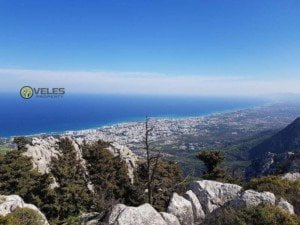
The history of Northern Cyprus consists of numerous milestones, a detailed account of which will follow below. The island began to be inhabited in the Neolithic period, which marked the beginning of life in Cyprus. In the distant past, as a result of natural phenomena and cataclysms, a significant area of land separated from the coast of the Levant. This is associated with the formation of the island of Cyprus. This is how this huge and majestic island was born.
The history of Cyprus consists of numerous milestones. A detailed story about which will follow below. It began to be inhabited in the Neolithic period, which marked the beginning of life in Cyprus.
The first traces of human civilization found on the territory of northern Cyprus date back to the beginning of the 8th millennium B.C. At the very tip of the Karpas Peninsula, the oldest settlement dating back to the Neolithic period was found. Life in Cyprus spread from this settlement. The Syrian coast and the Karpas are separated by only 95 km. Rocky islets at the extreme point of the Karpas Peninsula are the remains of a once-existing chain of rocks stretching from the island to the Syrian coast. Presumably, the first settlers got to the island along it.
Already in those times, ancient people were engaged in agriculture. At that time, agriculture was developing slowly. It mainly consisted of animal husbandry with a small share of agriculture and handicrafts. People domesticated dogs, goats, sheep, and, according to other sources, cattle and pigs. They were engaged in fishing and began to make the simplest ceramics from local clays.
It is evident that the first people on the island were of the same ethnic type as the population of the Levant, the Semites. It is known that in the 7th millennium BC, the migration of the Semitic tribes of “Hamites” from the Levant to the west began. On the migration routes of these tribes lay the island of Cyprus. The migration of the “Hamites” continued until 4500 BC.
After a large part of the Zafer ridge sank to the bottom, not many dared to get to the island from the Syrian coast on small rowing boats. The population of Cyprus grew very slowly. During this time, people on the mainland discovered the process of smelting copper and making bronze products. Horses were tamed and the wheel was invented. The next century in the life of the island began…
History of North Cyprus: Bronze Age
In the Bronze Age, between 3500 and 2750 BC, a new wave of settlers arrived on the island of Cyprus from the southern coast of Anatolia (now Turkey), which is only 60 km from the island. By their ethnic type, these tribes belong to the Hittite people (Caucasian group). Numerous new settlers from Asia Minor brought domesticated horses, bronze weapons, and more advanced pottery to the island. Since the newly arrived settlers already had the skills to work with copper, they began to actively use the deposits of copper ores.
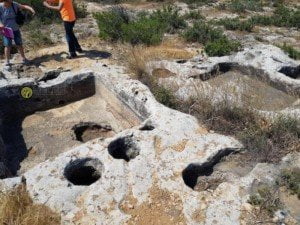
Arriving on the island, numerous settlers subjugated the older Semitic population. There was an assimilation of the ethnic groups that existed in Cyprus: the ancient Semites and the new Hittites.
A people was formed – ethno-Cypriots, who are rightfully considered the oldest population of the island of Cyprus.
Ethno-Cypriots conducted active trade with the inhabitants of the island of Crete – the Pelasgians. The Pelasgians, being good seafarers, appeared on the west coast of Crete, where they founded their trading settlements. The main goods were ceramics and weapons, in the production of which the Pelasgians made significant progress.
Around 1700 BC, the first urban-type settlements appeared. They became centers for the production of copper and ceramics.
Alasia
One of the settlements of ethno-Cypriots was formed in the east of the island. It was called Alasia and quickly became the main commercial center of Cyprus. From here there was a brisk trade with Syria, Anatolia and Crete. Profitable trade relations with Ancient Egypt were established.
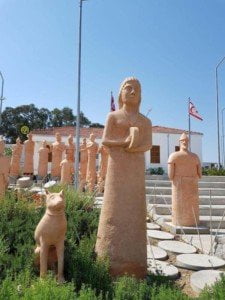
One of the leaders of the Achaean retinues, the legendary king Minos, marries the queen of the Cretans and founds a new dynasty. Under his descendants, Crete experienced a flourishing of culture. Samples of his new goods – weapons, ceramics and jewelry – are imported to Cyprus. The Minoan culture had a strong influence on the archaic Cypriot art style.
On the basis of the Hittite writing, ethno-Cypriots created their own alphabet.
In 1400-1300 BC, ethno-Cypriots exported copper with the help of small ships carrying about a ton of ingots. In exchange, gold, silver, ivory and ceramics were imported to the island.
Cypriot copper was in great demand throughout the eastern Mediterranean, and especially in Egypt. This is evidenced by the correspondence between Pharaoh Amenhotep IV (1375-1385 BC) and the king of ancient Alasia, found by scientists in Egypt.
The heyday of the ethno-Cypriot civilization dates back to the period from 1400-1200 B.C. At this time, Alasia became one of the largest trading centers of the ancient world. On the Syrian coast, in the Ras Shamra region, a large colony of ethno-Cypriots was founded, where goods were stored and from where extensive wholesale trade was conducted.
In Syriac ancient texts, the island is called “Yataniya”. It is possible that in the language of ethno-Cypriots it sounded like “Koper”.
The Achaeans and the Development of Cyprus
The end of the Minoan civilization came in 1300 B.C. At this time, Crete was captured by the Achaeans and established the power of the Knossos dynasty there. The Achaeans took over the trade relations of the Cretans. During their many trade expeditions to the island, they begin to look more closely at the vulnerable points of the city walls of Alasia. But the time for the Achaean invasion of Cyprus had not yet come.
In 1290 BC, a war broke out between the Hittite Empire and Egypt for supremacy in Palestine and Syria. In the battle of Kadin, the pharaoh’s army was defeated. The Hittites also sent troops to Cyprus to close the Egyptians’ access to copper. A powerful Hittite army stormed Alasia. Until 1200 BC, the island of Cyprus was dependent on the Hittite Empire. The Hittites used Cyprus as a place of exile for noble criminals. This is evidenced by clay tablets from the ancient capital of the Hittites. In Cyprus, the limited power of local kings has been preserved. The city of Alasia quickly recovered and was significantly fortified.
The fall of the Hittites
In 1200 BC, the invasion of eastern Anatolia began by the Phrygian tribes, who crossed the Dardanelles to Asia Minor. A long war with the Phrygians led to the fall of the Hittites. This allowed the kings of the ethno-Cypriots to get rid of the oppression of the Hittite Empire. At the same time, allied ties were established with the Achaeans, who sent a large military expedition to the western coast of Asia Minor.
The city of Troy was located here. This ancient state controlled the regions of the Dardanelles and the Sea of Marmara. Troy was an ally of the Hittite Empire. Homer’s poem “Iliad” describes the episode of the Achaean king Agamemon receiving a beautiful battle chain mail, which was sent as a gift by the king of Cyprus – Kyniros. Homer uses the Greek pronunciation of the ethno-Cypriot name of the king in the poem – Kunea. The Trojan War lasted from 1194 to 1184 B.C. The Trojans received military support from the Hittites, but due to the war with the Phrygians, it could not have been significant.
After the fall of Troy, the Achaeans began to establish fortified outposts on the coast of southern Anatolia. There is evidence of Cyprus’ close ties with the Achaeans, who are becoming the main trading partners of the island. Apparently, it was then that some heroes of the Trojan War appeared in Cyprus. Permanent Achaean trading settlements were founded on the island. However, Cyprus was a fairly strong state and easily controlled the settlements of foreign merchants.
Achaeans
In 1800 B.C., the Achaeans undertake a major military campaign in Palestine and invade Egypt. This Achaean expedition was called in the Egyptian chronicle “the invasion of people from the sea”. Egypt, weakened by the recent war with the Hittites, manages to repel the attack of the “people from the sea” with great difficulty. However, the Achaeans established control over Palestine. The local peoples called them the Philistines.
The identity of the Philistines and the Achaeans is evidenced by the nature of their pottery. The Philistines themselves told the locals that they came from Crete and from the country of “Hittim”, as the locals called Cyprus. Soon a war broke out in the Peloponnese between the Greek tribes. The inhabitants of the north, the Dorian Greeks, took advantage of the fact that the main forces of the Greeks, the Achaeans, had gone to Palestine. The unexpected attack of the Dorians put the Achaeans to flight, first to Crete, and later to Palestine. The arrival of the new settlers led to a conflict between Cyprus and its recent allies. The Achaeans decided to establish full control over Cyprus.
Phoenicians in Cyprus
In 1100-1075 BC, a war broke out between the kings of Alasia and the Achaeans. The capital of the island was taken by storm, and the inhabitants were relocated to one of the trading posts of the Achaeans – Salamis. The Achaeans gradually took over the cities of the ethno-Cypriots and built their own, such as Soloi and Thomasos. The process of assimilation and subjugation of the indigenous population of the island to the Achaeans was stopped only after a military defeat in 975 BC, as a result of the uprising of the Palestinian population led by King David. The collapse of the main Achaean military forces in Palestine and the loss of cities in Greece halted the conquest of Cyprus. Peace was established. The territory of the island was divided between several city-states. Among them remained the ethno-Cypriot cities of Amathus, Marion and Lapithos.
Phoenician merchants appear more and more in Cyprus. They called the island of Cyprus “Kittium”. The Phoenicians recreated Kittion destroyed by the Achaeans and founded several more settlements. With their appearance in Cyprus, they learned the techniques for making bichromic ceramics, which were widely exported to neighboring countries. Dishes were also produced here according to Mycenaean models. Although after the destruction of the Mycenaean civilization, it ceased to come to Cyprus, local craftsmen successfully copied the Mycenaean products they knew. For many centuries, the island of Cyprus became a “bridge” between the first state formations of the Mediterranean and found itself at the crossroads of ancient civilizations.
History of Northern Cyprus: The Archaic Period and the Assyrians in Cyprus
2800 years ago, a new historical era in the development of the island of Cyprus began – the archaic period. It is marked by the emergence in the east of the first “superpower” of the ancient world – the Assyrian Empire. Its king Sargon II (724-705 BC) subjugated the seven main cities of Cyprus, which were obliged to pay tribute to the Assyrians. Assyrian rule dried up in 612 BC, after the conquest of Babylon by the armies of the Medes and Scythians. The cities of Cyprus gained freedom, but not for a long time.
The domination of the Egyptians
Ancient Egypt, which increased its military strength, intensified its war with the alliance of the Phoenicians and Cypriot cities. In a naval battle, the fleet of Pharaoh Hofri turned out to be the winner, and his heir Ahmes III (569-525 BC) landed troops on the island and subjugated it to his power. The king of Alasia, Eleuton, managed to establish good relations with the Egyptians and helped them capture all the cities of the island. The most ancient known coins of Cyprus date back to the reign of Eleuton. The inscriptions on them were made in the language of ethno-Cypriots, which was then spoken by most of the inhabitants of the island.
The tribute paid to Egypt was onerous. Cyprus and Phoenicia began to seek protection from the new superpower – the Persian Empire. With its help, the cities of Cyprus in 545 BC freed themselves from the power of the pharaoh, becoming vassals of the Persian kings. Persian hegemony was established in Cyprus for many years.
Classic period in Cyprus
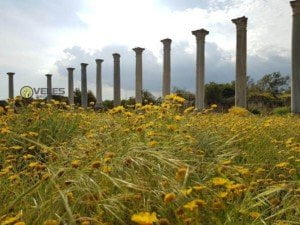
In the history of Cypriot art, this period is called “classical” due to the original combination of ethno-Cypriot, Eastern and Greek cultures. During this period, local craftsmen began to make ceramics and jewelry of high quality.
At this time, serious differences began to appear in the political life of the island in the views of the Greek population and the descendants of the indigenous inhabitants – ethnic Cypriots. Cities dominated by ethno-Cypriots and Phoenicians: Amathus, Kition, Salamis, Marion, were satisfied with the position of prosperous Persian protectorates.
The cities of Tamasos and Sholoi, founded later, which were mainly inhabited by Greeks, supported “Hellenic solidarity”. In 450 BC, they joined the revolt of the Greek colonies in Asia Minor and received help from Athens. Greek expeditionary forces appeared on the island. Stability and prosperity were replaced by the Thirty Years’ War.
The conquest of the island by the Greeks
The second period of the conquest of the island by the Greeks began. For a short time, the Athenians managed to subjugate most of the cities of Cyprus and establish the power of the Greek dynasties of Theocrides. King Oneilos, who enjoyed extensive military assistance from Athens, began the siege of Amathus, the last city ruled by the kings of the ethno-Cypriots. To help the ethno-Cypriots, Persia sent a strong expeditionary force and fleet to the island.
In the naval battle, the Greek fleet was victorious, but in the decisive battle on the plain near Salamis, the combined forces of the Greek cities of Cyprus clashed with a well-trained Persian army. In the midst of the battle, the Spartan Stasnor went over to the side of the Persians and led to them war chariots, which formed the main striking force of the troops of the Cypriot cities. Oneilos with a detachment of the best Greek mercenaries managed to break through the battle formations of the Persians and kill the military commander Artibios. The outcome of the battle was decided by the warriors of Amathus – ethno-Cypriots who fought on the side of the Persians. They surrounded Oneilos and killed him. The king’s head was brought to Amathus as a war trophy and later buried by the priests.
History of Northern Cyprus and Persian Rule
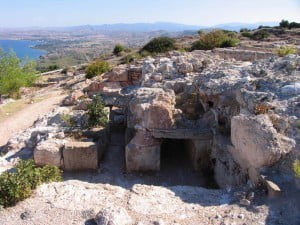
Persia’s domination of Cyprus was restored for a long time. In 480 BC, 150 Cypriot ships took part in the campaign of the Persian king Xerxes in Greece.
Cyprus remained the cherished target of Athens’ military operations. In 478 BC, an expeditionary force landed on the island again. He used Cyprus as a base for a military campaign against Egypt (as he did 700 years ago!). Despite the efforts of the Athenians, the descendants of the ethno-Cypriots, relying on Persian support, were able to hold Amathus and Kition.
The Greek language gradually began to supplant ethno-Cypriot. The inscriptions on the coins of Salamis were already made in Greek. All this contributed to the development of trade with Greece and the prosperity of Greek art.
In 351 BC, the kings of Cyprus made an attempt to get rid of Persian rule, but realizing that the Persians could not cope with them, they turned to internal problems, waiting for the emergence of some new external force capable of crushing the Persian superpower.
The main trading partners of Cyprus were: Greece, Egypt, the Levant, the islands of the Aegean Sea and the cities of Asia Minor. Cypriot goods filled countless Slavic cities of the Black Sea region and the Crimea.
History of Northern Cyprus: Alexander the Great and the End of Persian Rule in Cyprus
In 336 B.C., a power capable of crushing the Persian superpower appeared on the political horizon of the eastern Mediterranean in the person of the Macedonian king Alexander the Great. Having conquered Greece, the great commander made a rapid campaign to Asia, to the heart of the Persian Empire. His military gift allowed him to defeat the Persian army at the Battle of Issus in 333 BC, which marked the end of Persian rule in Asia and the eastern Mediterranean. But the sudden death of the great commander in 323 BC plunged his state into chaos. A long war began between the commanders of the Macedonian army for the division of the inheritance of the great leader. Cyprus was challenged by several claimants. And all because of its natural resources – copper and scaffolding. For 27 years, the island changed hands.
By the end of the struggle of the Macedonian commanders for the island, all local royal dynasties were destroyed. Ptolemy won, who also received control of Egypt. Under the rule of the dynasty founded by Ptolemy, Cyprus was for two and a half centuries. But the Ptolemaic dynasty, having become an ally of Rome, became too dependent on it.
Roman Senate
In 81 BC, there was such an incident when Senator Clodius Pulcher was kidnapped by pirates. But soon he fled and by chance ended up in Cyprus. There he turned to Ptolemy of Cyprus for financial help, but he ordered to drive the “impostor” out. The senator, having contracted as a sailor on a merchant ship, was still able to return to Rome. Having received the important post of tribune there, he made every effort to seize the island by Rome. In 58 BC, the Senate sent a small military detachment to Cyprus, which established Roman power without any resistance.
Under the rule of the Roman Senate, the island remained until 47 BC, when the illustrious queen of Egypt, Cleopatra, received the island as a gift from her lover Mark Antony. He kept Cyprus under her rule, but after losing a naval battle to his rival Octavian in 42 BC, he committed suicide. Cleopatra preferred the bite of a poisonous snake. With her death, a long period in the history of the island ended, when Cyprus, being on the main routes of civilizations of Western Asia and the Mediterranean, managed to create its own peculiar artistic style and become one of the main trading centers of the ancient period.
History of Northern Cyprus: The Roman Empire and the Spread of Christianity
The population of the island lived well under the rule of powerful Rome. Cyprus was located far from the borders of the empire and the theaters of military operations. Cities were governed according to the Roman model – municipalities and had significant independence in solving internal issues, up to the right to issue their own copper coins. The Roman proconsul, whose residence was in the palace of Ptolemy in Paphos, controlled only the collection of taxes and arbitration. Rome did not keep significant military forces on the island, limiting itself to the nominal military presence of a squadron. Remaining an important center for the production of ceramics and copper, engaged in the intermediary grain trade between Egypt and the western provinces of the Roman Empire, Cyprus lived for a long time in tranquility and prosperity, Roman culture and art developed here, mixing with the Greek, it created an extraordinary flavor.
Apostles Paul and Barnabas in Cyprus
In 45 AD, the disciples of Jesus Christ, Paul and Barnabas, arrived in Paphos with an apostolic mission. The latter came from a Jewish family in the city of Salamis. The apostles converted the proconsul Sergius Paul to Christianity, which contributed to the rapid spread of the Christian faith on the island. The population was then multinational. Although the Romans did not settle here, limiting themselves to visiting the temple of Aphrodite once a year, the arrival of settlers from other provinces of the Roman Empire was quite impressive. The situation changed when significant masses of Jews from Palestine began to move to the island.
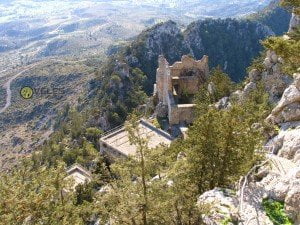
The inhabitants of Palestine, who sought refuge from the wars between the generals of Alexander the Great, appeared on the island of Cyprus under the Ptolemies.
The king of Judea, Herod the Great, leased the copper mines of the island from the Senate and resettled thousands of Jews here for heavy mining work. All this did not bother the Greek merchants. However, the flow of settlers from Palestine increased. They came to make up the majority of the population of Salamis, the main trading center of Cyprus, whose ancient stock exchange, the “agora”, was one of the largest in the Roman Empire. The Jews gradually took over the wholesale trade in Egyptian bread, becoming increasingly dangerous rivals for the Greeks.
The aggravated tension between the Greek and Jewish groups of the island’s population led to bloody clashes in 116-117. As a result of bloody intercommunal clashes, several thousand people died.
Salamis, the main arena of the epochs of unrest, was completely destroyed. The local Greeks, with the support of high-ranking compatriots living in Rome, managed to convince the Senate that only the expulsion of the Jews could return a quiet life to the island. After much deliberation, the Senate came to a decision and the surviving Jewish inhabitants were resettled in Palestine. Although Jews were forbidden to enter the island on pain of death, a small number of them returned to Cyprus within a few years. But it never reached its former number and importance.
In 269, a wave of conquerors of “living space” – the “Goths” – swept through the island, but they, too, did not hesitate to go to the Balkans.
History of Northern Cyprus: The Byzantine Empire and Arab Raids
The city of Salamis was recreated with its former splendor under Emperor Constantine and renamed Constantia. It again became the capital of Cyprus. In 330, the capital of the Roman Empire was transferred from Rome to Constantinople and Christianity became the official religion. In 395, the Roman Empire split into western and eastern, and Cyprus became part of the eastern Empire, which was called Byzantium and existed for about 8 centuries.
In the Byzantine Empire, bishops were important figures. The Cypriot bishops were not satisfied with the submission to the Antiochian Apostolic Patriarchate and at the Council of Ephesus in 413, they achieved the right of autocephaly – self-government. The decree of the Council was to be legitimized by the emperor Zeno. The Archbishop of Cyprus, in order to assure him of the validity of his claims, used the fact that the tomb of the Apostle Barnabas was found in the vicinity of Salamis. Unable to resist the arguments of the bishops, the emperor Zeno proclaimed the Church of Cyprus autocephalous in 488. The church received the prestigious title of “apostolic”. Everything was going so well that only epidemics and natural disasters could interfere with the development and well-being of the island, but then began a long three-hundred-year stage of Byzantium’s wars with the Arab caliphs. Having begun in Palestine, military battles between the Byzantines and the Arabs quickly assumed a large-scale character.
The Spread of Islam in Cyprus
In 632, Abu Bakr, a relative of the Prophet Muhammad, landed a military landing force on the island and took possession of it for a short period. The Byzantines, sending troops, returned Cyprus. Then, in 647, Caliph Damascus Muwaya arrived on the island with a fleet of 1700 ships. Taking Constantia by storm, he took possession of Cyprus. The inhabitants had to pay the caliph an annual tribute of 7200 gold coins, remain loyal and report on the landing of Byzantine troops on the island. After taking control of Cyprus, the Arabs left their garrisons there and began to build mosques. A fairly significant Muslim population arose on the island.
Thus, during the period of the Arab-Byzantine troops, Islam spread among some of the inhabitants of the island. Muslim religious centers were built. The most important of which were the Halla Sultan Tekke Mosque. As well as the tomb of Islamic martyrs in the north of the island – Tekke Ghazart Omar.
The Arabs brought new types of crops to Cyprus. The production of sugar and silk became the main branch of the island’s economy.
Arabs and the Christian population of Cyprus
The Arab caliphs of the Ommeyad dynasty were quite lenient towards the local Christian population. Under them, a peculiar and unique fusion of the culture of the Muslim East and the traditions of Rome arose in the Middle East. Masters of mosaic and fresco painting from Cyprus decorated the mosques and private residences of the caliphs. For example, the main mosque of Damascus under Caliph Walid I. Creators were perfectly able to depict not only nature, but also figures of people, even naked ones. The weakening of the position of the Arabs in Cyprus began in 683.
Under a peace treaty with the Byzantine Emperor, the Arab garrison was withdrawn and the island was divided into zones. Then the unpredictable Byzantine Emperor Justinian II relocated the Christian part of the island’s inhabitants to Asia Minor, where the city of Justinianoupolis was built on the shores of the Sea of Marmara. Another part of the island’s population fled to Syria. All this led to the collapse of the economy and the destruction of the cities of Cyprus. Only in 698 did the Byzantine Emperor Tiberius III and the Caliph of Damascus sign peace. The population was able to return to Cyprus, both from Byzantium and from Syria. The appearance of a community of Maronite Christians on the island dates back to this period.
Rule of Byzantium
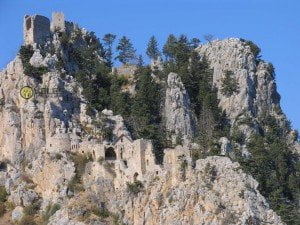
The rule of the Arabs on the island lasted another 200 years, but the Byzantines again made an attempt to retake the island. In 965, the brilliant commander Nicephorus Phokas inflicted a number of defeats on the Arab troops and the island returned to the control of Byzantium. A slow increase in the number of its inhabitants began. Along with the new Byzantine monasteries built, the old cities were also restored. The city of Lefkosia, conveniently located in the center of the island away from hostilities, increased its importance. It was rebuilt and became the residence of the Byzantine governor of Cyprus.
Cyprus, during the First Crusade, played an important role as a food base for the Crusader army during the siege of Antioch. The new neighbors, the crusaders, turned out to be no less dangerous than the Arab caliphs. Prince Reynold of Antichaeum with Gascon knights and Armenian mercenaries attacked the island in 1156. Having defeated the small army of the Byzantine governor, the Gascons and Armenians engaged in robbery and robbery for three weeks. After plundering the inhabitants and learning of the approach of the Byzantine fleet, the prince’s troops left Cyprus. Since then, the island’s population has lived in constant fear, waiting for more attacks.
History of Northern Cyprus: The Last Byzantine Governor and the First Briton in Cyprus
In the twelfth century, the Byzantine Empire began to experience increasingly serious military difficulties, with difficulty repelling numerous raids by warlike neighbors on its western and eastern borders. The weakening of imperial power led to several revolts against the governors of Cyprus. The last Byzantine governor of Cyprus, Isaac Doukas-Komnenos, was the grandson of the Byzantine Emperor Manuel I. Taking advantage of the palace coup in Constantinople, Isaac declared himself Emperor of Cyprus. He appointed one of the monks as the patriarch of the island and he crowned him.
Isaac turned out to be a cruel and greedy ruler, robbed his people to the bone. Having learned that his son had converted to the “Latin faith”, Isaac executed him. With the help of detachments of Armenian mercenaries, Isaac kept the inhabitants of the island in constant fear. Having once been imprisoned by the Crusaders, Isaac hated them with a mortal hatred. He promised Caliph Saladdin not to provide any assistance to the Crusaders and not to allow them to land in Cyprus. This continued until the spring of 1191.
At this time, two crusader ships were wrecked in the Gulf of Limassol during a strong storm. The third ship was lucky enough to take refuge in the harbor of Limassol. Issak ordered to detain all the crusaders on the surviving ship. It turned out that there were two noble ladies on the ship. These are the bride of King Richard I of England, Princess Berengaria of Navarre, and the king’s sister, Princess Joanna. They had a strong guard with them, consisting of selected English knights and the best royal archers. The ladies asked for fresh water and to be allowed to wait at the port for the arrival of King Richard I’s ships, the Lionheart. In Palestine, the army of his ally, the King of France, was already waiting for him. The Third Crusade was beginning.
The Impostor Emperor
The self-styled “emperor” Isaac decided to take the king’s fiancée and sister hostage in order to prevent the Crusaders from landing on the island. Forbidding the delivery of fresh water to the ship, he invited the ladies to move to his castle in Limassol. The cautious princesses declined the offer, and their guards were put on full alert. Then Isaac summoned troops from Nicosia to seize the ship by force, but he was too late. Several of Richard’s Lionheart ships rushed into the Limassol Bay at full sail. The king was in a hurry to Palestine, but when he learned about the loss of two of his ships and the refusal of Emperor Isaac to provide assistance to the surviving ship, which caused the princesses to have a stomach upset, he was furious and decided to teach the impudent man a lesson.
The king of England landed his troops on the shore and the self-styled “emperor” barely managed to escape to Nicosia. Richard, having sent envoys for support to Palestine, solemnly celebrated his wedding with Princess Berengaria in the church of St. George, in Limassol. Here she was crowned with the English crown. King Richard sent an ultimatum to Isaac, in which he offered to pay compensation of 20. 000 gold coins and put two new ships at his disposal. To guarantee the future loyalty of the ruler of Cyprus, his daughter had to go to Palestine. Isaac did not want to part with the money and break the treaty with Saladdin, whom he feared more than King Richard. Hoping for the small number of forces of the English king, he declared war on the crusaders. But King Richard managed to receive reinforcements from Palestine.
The Last Days of Byzantium
The army of Issac Doukas-Komnenos was defeated by a fierce attack by the knightly cavalry of the Crusaders in the Battle of the Plain near Nicosia. Isaac retreated to the mountains, where he hid from his enemies in one or another hard-to-reach castle. He was captured by the Crusaders in the monastery of the Apostle Andrew and taken to Richard. Isaac asked the king for only one thing – to put him in chains of silver and gold, as was the case in Byzantium during the arrest of members of the imperial family. Richard agreed, and the shackles were made overnight. The Crusaders took the former self-styled “emperor” to Syria, and his daughter was sent to Normandy. The island of Cyprus was declared the property of the English monarchs. Richard took half of the money that each family of the island had, appointed an English governor and sheriff, left a small garrison and went to Palestine.
Templars, Lusignans, Venetians
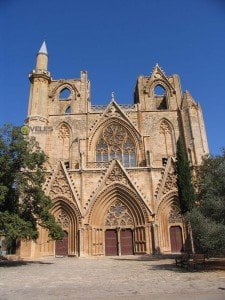
During the Third Crusade in 1191, the island was conquered by the Crusaders. But King Richard the Lionheart of England understood how difficult it would be to govern the island. Therefore, he decided to sell it to the Templar Order. After the uprising on the island, the Templar Order rejected it and Richard resold it to Guy de Lusignan. Thus, the rule of the Frankish kings came to the island of Cyprus, which would last about 300 years. Catholicism became the state religion on the island, but the Orthodox Church was preserved. The mores of feudal Europe reigned in Cyprus. Nicosia became the capital of Cyprus. In 1489, Queen Caterina Cornaro of Cyprus abdicated the Cypriot throne in favor of Venice, thus ending the period of the reign of the Frankish dynasty.
After the abdication of the last Queen of Cyprus, Catarina Cornaro, in favor of the Republic of Venice, Cyprus became a military outpost in the eastern Mediterranean. For more than 80 years, a banner decorated with the coat of arms of the Republic of St. Mark with the image of a lion flew over the island. But the arrival of the Venetians did not improve the economic and cultural situation on the island. The degree of dissatisfaction with the administration of the Venetians was so great that a mass exodus from the island began. Venetian domination of the island culminated in the capture of the island by Turkey after a bloody and prolonged war.
History of Northern Cyprus: Ottoman Empire
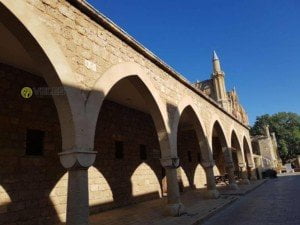
By 1573, Turkish rule was firmly established in Cyprus under the onslaught of the Ottoman army. From a prosperous Frankish kingdom, Cyprus turned into a backward province of the Ottoman Empire. Mustafa Pasha’s army left Cyprus, leaving behind a small garrison of 1,000 Janissaries and 2,500 Spagas. The new authorities created the post of Dragoman, the official translator for the governor of Cyprus. His duties included the management of the governor’s office. The Archbishop of the Orthodox Church of Cyprus received the title of “Ethnarch” and was considered the head of the Greek population of the island. There were also serious changes in the life of ordinary people. Serfdom was abolished, and the land was transferred to the peasants. The Greek population was allowed to carry out any transactions with land, the price of land became fixed.
Over time, the sultan’s government began to resettle Muslims from Anatolia on the island. In the first two years, 8,000 Turkish families moved to the island. The settlers were given lands that belonged to the Catholic Church and the Senate of Venice.
Claimants to the Island
But soon, after the capture of Cyprus by the Ottoman Empire, Duke Charles of Savoy, heir to Queen Charlotte, claims the island. The duke offered the Sultan to transfer Cyprus to him as a vassal, to which the Sultan refused. But the Duke of Savoy did not give up his attempts to retake Cyprus. He offered the Archbishop of the Orthodox Church of Cyprus to help him gain power over the island. The terms of the proposed capitulation provided for the preservation of the position of the church on the island that it occupied under the rule of the sultan. The archbishop was ready to return their churches to the Catholics, on the condition that there would be no Jesuits, Spaniards, Genoese, and Protestants on the island. Questions of defense were transferred to the Duke of Savoy, but the right to form a government remained with the archbishop. Later, the archbishop abandoned the idea of restoring the monarchy on the island and turned his views to Greece.
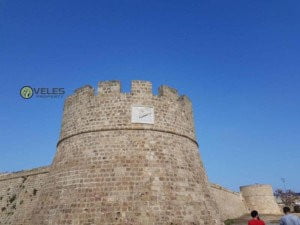
Corruption was rampant on the island. The archbishop, who wielded great power, and Dragomon collected taxes from the population. The extortion of taxes was carried out with incredible cruelty.
The Idea of Enosis
From 1817, a revolutionary movement broke out in Greece. Following this, representatives of various secret societies appeared in Cyprus. Archbishop Kypreanos did not want to see them, but then began to allocate significant sums of money for the needs of propagandists. These actions served as the beginning of the financing of underground organizations that preached the ideals of “Enosis” about the unification of Cyprus and Greece into one state.
The idea of “Enosis” attracted the archbishop because in their rank and privileges the archbishops of Cyprus stand above the hierarchs of the Greek Orthodox Church. Therefore, with the unification of the countries, the Archbishop of Cyprus would have to become the head of the Hellenic Orthodox Church. This simple reason prompted the archbishops of Cyprus to support the ideologists of the “struggle against Turkish oppression.”
The clouds of the First World War were gathering in Europe. Germany’s ideas about the German annexation of Cyprus, Crete and Rhodes alarmed the British Prime Minister, Lord d’Israeli. The British government begins negotiations with Turkey on a military alliance. Cyprus, with an ideal strategic position in the eastern Mediterranean, became the “unsinkable battleship” of the British fleet. Negotiations on the organization of a British military base on the island were successful. And in June 1878, the agreement between the parties was signed. On July 1, 1878, British Admiral Howe received orders to sail with his squadron from Egypt to Cyprus. And already on July 12, the British flag was raised in Nicosia. Thus, Cyprus came under the control of the British royal administration.
And again the British flag
The Queen’s High Representative became the head of the English royal administration on the island. Under him, the Legislative Council functioned, which consisted of 4 Englishmen and 4 local residents. The British completely removed the Cypriot Orthodox Church from power. The archbishop put up with this state of affairs, since there was a possibility of the return of the sultan’s power to the island.
In 1882, an administrative reform was carried out on the island. As a result, the Executive Council was created, consisting of 6 appointed members and 12 elected members (9 from the Greek community, 3 from the Turkish community). The Queen’s High Representative had veto power and approved all decisions of the Executive Council. Also, thanks to the British authorities, the island had its own legislation that controlled the education and health care systems. Significant funds were invested in the development of the road network, the mining industry, and the construction of the port. A railway was even built in Cyprus.
The UK has regularly stated to Turkey that it is ready to return Cyprus to its jurisdiction, provided that all the clauses of the treaty are respected. But after the outbreak of war, when Great Britain and Turkey found themselves in different military blocs, the terms of their alliance became invalid. Cyprus was declared a dominion of the Crown.
In October 1915, Greece had a chance to annex Cyprus. Great Britain, concerned about the weakening of the Entente, was looking for new members, and invited Greece to enter the war on the Balkan front near Salonika. For this, she promised to hand over Cyprus to Greece after the victory in the war. But Greece did not agree, waiting until 1917, when the question of the victors would leave no doubt, so it missed its chance to take possession of Cyprus. And the UK, in turn, concluded a secret “Sykes-Picot” treaty with France, aimed at blocking all attempts by Greece to get Cyprus in the future.
History of North Cyprus and British Rule
The British administration, after the end of the war, actively took up the management of the island. A number of reforms were carried out: the establishment of censorship of the media, the reform of the education system, the Department of Antiquities was organized, whose work was aimed at preserving historical monuments and studying the ancient history of Cyprus.
But the supporters of Enosis, under the leadership of the Archbishop of Cyprus, created a “National Assembly”, which was a parallel illegal executive branch. The “National Assembly” wanted Cyprus to join Greece. Supporters of Enosis organized an attempted mutiny in Nicosia and burned down the palace of the British governor. The British government, in turn, increased the number of troops on the island and in 1933 blocked the election of a new archbishop of Cyprus.
In the Mediterranean during the Second World War, Cyprus was the rear of the British forces. Many Cypriots participated in the war in the ranks of the British army. In 1947, the Labour government allowed the election of a new archbishop of Cyprus, which was a fatal mistake for British politicians.
History of Northern Cyprus: The Troubled Years
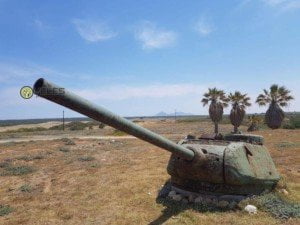
In Cyprus, an underground terrorist organization EOKA was created, under the leadership of the former colonel of the Greek army Grivas. Grivas believed that the natural conditions in Cyprus were ideal for guerrilla warfare on the island. The only concern was the Cypriots’ natural inclination to a calm peaceful life and their distrust of all kinds of adventures, but he counted on the enthusiasm and enthusiasm of the youth. In 1949, Archbishop Makarios II of Cyprus organized a “referendum” to ascertain the attitude of the Greek population to the ideas of “Enosis”. As a result, the Archbishop announced that 98% of Greeks in Cyprus support the idea of joining Greece.
In July 1954, the new Archbishop of Cyprus, Makarios II, met with Grivas in Athens and together with him created a conspiratorial center, the Revolutionary Council. This center was to consider the preparation and coordination of the company for the implementation of Enosis in Cyprus. The secret organization EOKA created by Grivas in Cyprus involved a large number of young people, students and high school students in its ranks. Terrorist attacks claimed more and more lives, killing British soldiers, English tourists, Anglophile Greeks and policemen.
Tense situation
The police force consisted of the local population, Greek and Turkish Cypriots. In this regard, the actions against the police caused increasing tension between the Greek and Turkish populations. Turkish Cypriot leaders have made statements that they do not accept the idea of Enosis and prefer to remain British citizens. Turkey, for its part, has closely followed developments in Cyprus and has made it clear that it is using all measures to protect the Turkish population on the island. But terrorist actions continued.
Greece, under pressure from NATO countries, agreed in 1957 to remove the slogan of “Enosis” and guarantee the independence of Cyprus along with Turkey and the United Kingdom. The terror was stopped, which paved the way for the partition of Cyprus. The Cyprus question remained one of the main ones not only for the local population, but for the entire Mediterranean. In February 1959, in London, representatives of England, Greece, Turkey and the Greek and Turkish population of the island signed a package of documents that created the legal basis for the legislation of the Republic of Cyprus. On this island, the Independent Republic of Cyprus was formed.
Independent Republic of Cyprus
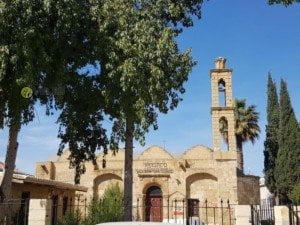
The constitution adopted in London granted equal political rights to the Greek and Turkish communities on the island and prohibited its annexation to another state. Archbishop Makarios was elected the first President of Cyprus, and Dr. Fazil Küçük was elected Vice-President. But the real goal of President Makarios was the speedy liquidation of the formed state. As well as the leadership of the United Hellenic Orthodox Church. In December 1963, President Makarios attempted a “peaceful coup d’état” by granting the Cypriot Parliament 13 amendments to the Constitution.
The main purpose of the changes in the Constitution was the removal of Turkish Cypriots from state structures and the creation of legal conditions for the accession of Cyprus to Greece. The Supreme Court of Cyprus rejected the amendments of President Makarios as unconstitutional. For this, the chairman of the Supreme Court was harassed and intimidated by Greek extremists, and was forced to resign. And state chaos began on the island.
History of North Cyprus and Independence Years
During the three years of independence, several Greek paramilitary organizations and “private armies” were created on the island. These organizations were intended to resolve the constitutional crisis by force. In 1964, the detachments of the “private army” of Grivas intended to capture the village of Erenkoy. This village was strategically important for the Turkish Cypriots. Only through the small harbor of this village could Turkish Cypriots receive weapons and equipment from Turkey for local self-defense units. The attack of the Grivas army was repulsed by the forces of TMT detachments with the support of Turkish aviation.
Turkish Cypriot families were forced to take refuge in villages surrounded by Greek terrorists, under the protection of the self-defense forces and UN units. In 1964, the Turkish Cypriots lost about 1,000 people and the Greek side about 20 people.
The number of Greek troops on the island reached 20,000 in 1967. But in violation of the Constitution of Cyprus, President Makarios created the Greek “National Guard” led by General Grivas. These actions were part of Akrit’s secret plan to forcibly implement Enosis. The documents of this plan were later published in the Greek press. During this period, 25,000 Turkish Cypriots were expelled from their villages and became refugees in their own country.
History of Northern Cyprus: Dividing the Island into Two Parts

On June 26, 1967, the Greek members of the Cypriot Parliament adopted a special “Resolution on Enosis”, which was never repealed. It recognized the annexation of Cyprus to Greece as the “historical national goal” of the Greek Cypriots. However, the National Guards resumed attacks on Turkish villages in November 1967. At this time, Grivas and President Makarios disagree on their goals. Grivas is eager for power, under his pressure Makarios is removed from the post of Archbishop. Even the death of Grivas in 1974 did not stop the crisis. On June 15, 1974, units of the National Guard and EOKA 2 militants attacked the government buildings of Nicosia and began shooting at Cypriot communists.
President Makarios fled to the British military base and left Cyprus. The Greek Cypriot National Guard attacked 33 Turkish villages at once and some of their inhabitants were killed. Therefore, on June 20, 1974, Turkey decided to use its right as a guarantor of the Zurich agreements. In order to prevent the annexation of Cyprus to Greece and to ensure the safety of Turkish Cypriots. Turkish troops were brought into the island, taking under the protection of the villagers, Turkish Cypriots in the north and center of the island.
History of North Cyprus
History of Northern Cyprus. On June 25, a peace conference on Cyprus opened in Geneva. On June 30, a protocol defining the obligations of the parties to restore peace on the island was agreed and signed. Turkey immediately withdrew its units to established areas in northern Cyprus. But the National Guard did not withdraw its units from the captured Turkish villages and continued to kill civilians. And when part of the Turkish population took refuge in the fortress of Famagusta, the Greeks organized its siege and shelling from the roofs of multi-storey buildings. The negotiations in Geneva were interrupted. The Turkish army established control over the entire territory of Northern Cyprus in three days.
From that moment on, there were no more ethnic clashes on the territory of Cyprus. In 1975, the process of diplomatic negotiations began with the mediation of the UN. The negotiations discussed the creation of a federal state in Cyprus and local self-government bodies in two national states. However, the negotiations were blocked by President Makarios, who returned to Cyprus. Thus, the already agreed conditions for the creation of a federal state in Cyprus were disrupted. The Turkish Cypriots unilaterally proceeded to implement the agreed plan and announced the creation of the “Turkish Federal State of Northern Cyprus”. This made it possible to form local authorities, establish a peaceful life and end the exchange of population between the national provinces of Cyprus in 1975.
Source: Free Internet
Prepared by: Julia Ozerje
If you have any questions regarding a residence permit, buying air tickets. As well as questions about apostilled powers of attorney – contact Veles Property. Our contact phone numbers: 0533 826 0449 (Diana), 0533 840 4838 (Vera), 0533 833 3398 (Irina)
Read more articles about North Cyprus here.
Follow the developments in Northern Cyprus in our Telegram and Instagram
Watch all our videos on the YOUTUBE channel VELES


